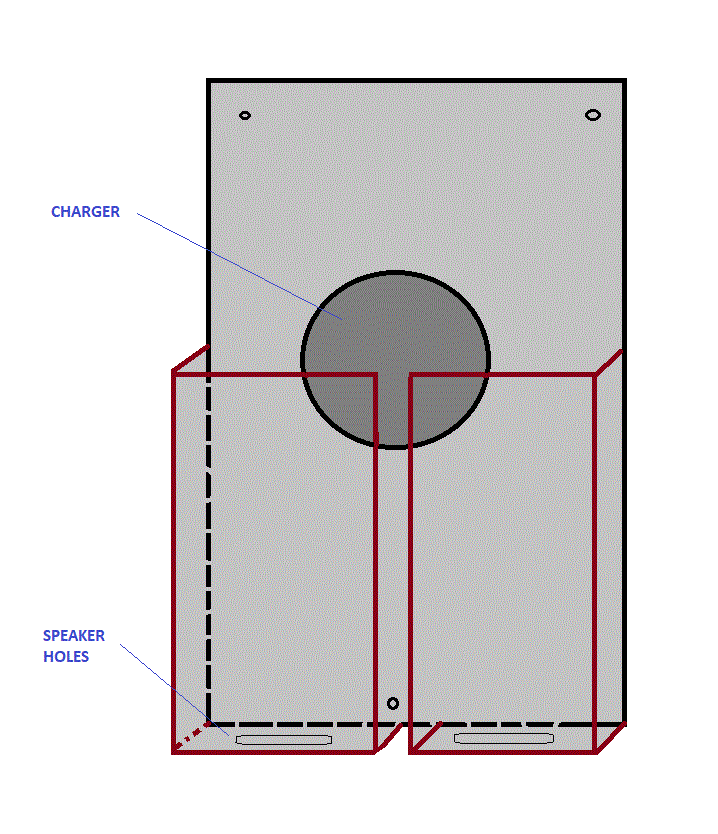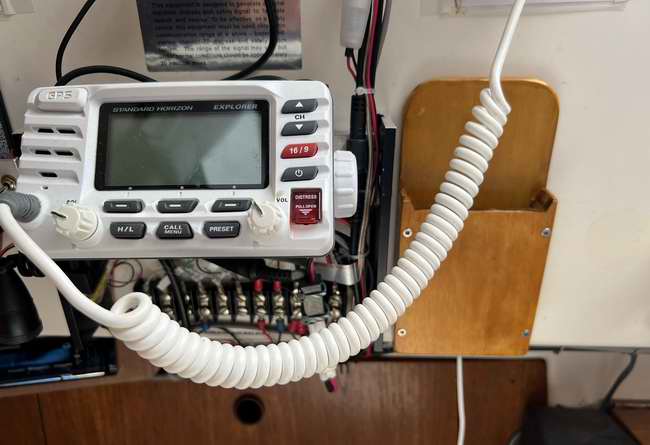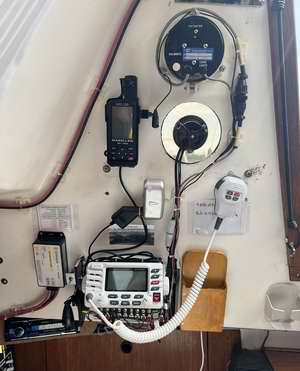| SJ23 Tech Tip E21, (Updated 2025-06-22) Bob Schimmel | |||
|
Wireless Charger for a Cell Phone - Convenient or what. |
|||
|
It is nice to have a convenient holder to drop my cell phone into where it is secure, dry, and is within audible range of the cockpit. The idea is that it can charge in the holder and that I can also see it to remind me to I take it home at the end of a float. I recently visited an Apple store to test how much magnetic interference their wireless charger has. My concern was interference to the steering compass in the cockpit. Not that I use a compass all that much on a lake but why create a problem. The people at the Apple Store were quite surprised when I pulled out my hand compass. The magnetic field of a powered charger extends ~12" without an iPhone resting on it and ~2" with an iPhone on it. If the charger is installed on the starboard side of the companionway, away from the port side steering compass as in Panache's case, there won't be any interference to the steering compass or the flux gate compass in the Tiller Pilot. Of course if the power is off, there is zero interference.
DESIGN - The wireless (inductive) charger is imbedded in the front of this holder since the iPhone will always lean to the low side, pressing against the charger. In addition, the magnet that is part of the charger holds the iPhone tight to ensure maximum charge current. LOCATION - A dry and convenient location is everything when it comes to storing a cell phone. For this reason the holder is installed against the starboard side of the companionway, away from rain and convenient to reach from the cockpit. Just drop it in, then get back to the helm. There is a long slot across the bottom to pass ringing through. For cockpit use it would be best to use a blue tooth ear bud. But I don't do well with ear buds while skiing or sailing so I'll continue to dive into the cabin. CONSTRUCTION - The holder is constructed of 1/4" plywood with dimensions to fit an iPhone 13Pro. The front of the holder stops just below the camera lenses on the back of the iPhone. The 1/8" thick MagSafe wireless charger is imbedded in the front of the holder to perfectly line up with the charging spot on the back of the iPhone. I used a router to gouge out a ~1/8" deep recess for a flush surface to protect the charger as the iPhone slides into or out of the holder. The charger and its cord are held in place with a dab of Shoe Goop. All wood is coated with Sikkens Cetol. The holder is mounted to the bulkhead with two vertical strips of double sided Alien Tape. The front panel is secured with 4 wood screws to service the charger.
POWER - To achieve optimum charge performance requires at least a 12V 20W Mophie USB-C/A car charger plugged in the 12V outlet that is switched via circuit breaker 10. The USB-C jack is for the Magsafe charger and the USB-A jack is for my buddies who show up with their old hardware. I'll keep my existing 12V USB-A charger and cord as backup. On my first use the 40% charged iPhone drew 900MA of charge current and was at 100% in ~30 minutes. This quick charging performance has more to do with the Mophie than the Magsafe charger. It will be interesting to see how much current flows when 2 phones are plugged in. VISIBILITY - The top third of the iPhone is exposed while in the holder to reveal, "I'm here!" This is much more visible than the black iPhone in the black leather case I used to use. Hopefully this is sufficient to remind me to grab it when I leave Panache! As ridiculous as this sounds I'm tired of driving back to Panache to pick up my cell phone. _______________________________________________________
USE - Boy is this holder ever convenient to use. I just drop it in with one hand, flip the breaker to charge and continue with what I'm doing. If I get significant rain I simply pull the sliding hatch closed. And, YES I can see it at a glance so I know where it is. No more padding down my pocket to search for it.
|
|||
|
Return to Tech Tip Index. . . . . . . . . . . . . . . Have a Question? |
|||


